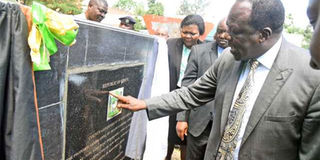Report paints rosy picture in counties

Kakamega Governor Wycliffe Oparanya launches the construction of roads in May in Kakamega town at a cost of Sh550 million. The governor on June 28, 2019 said counties have fostered great development. PHOTO | FILE | NATION MEDIA GROUP
What you need to know:
- The counties have cumulatively received Sh1.57 trillion in equitable share of revenue allocation from the national government since the inception of devolution in 2013.
- Projects are done at blatantly inflated costs as is the case with payments to suppliers.
- In the health sector, Mr Oparanya said that the counties have remained committed to strengthening health systems towards the implementation of Universal Health Coverage.
The Council of Governors (CoG) on Friday released its sixth State of Affairs Report highlighting significant strides in sustaining devolution gains in the 47 county governments.
According to the CoG chairman Governor Wycliffe Oparanya (Kakamega), the counties have cumulatively received Sh1.57 trillion in equitable share of revenue allocation from the national government since the inception of devolution in 2013.
This translates to 20 per cent of Sh7.8 trillion — the overall shareable revenue.
RAMPANT CORRUPTION
But even as Mr Oparanya painted a rosy picture regarding the county governments’ use of the money, he failed to address concerns about rampant corruption in most of the devolved units.
Throughout his speech that was heavy on the gains counties have made in the sectors of health, education, finance, urban planning and infrastructure among others, the Kakamega governor was silent on the efforts the counties have made to deal with rampant corruption among its officers.
This comes as the Ethics and Anti-Corruption Commission (EACC) CEO Twalib Mbarak told the Justice and Legal Affairs Committee (JLAC) of the National Assembly on Thursday that corruption is rife in counties.
Projects are done at blatantly inflated costs as is the case with payments to suppliers.
SH5 BILLION
Some of the cases being handled in various counties include 148 in Nairobi county worth Sh5 billion, 19 cases in Machakos county worth Sh1.4 billion, Mombasa has 53 cases worth Sh903.5 million, Uasin Gishu 31 worth 826.2 million, Malindi seven worth Sh84.5 million and Kisii 16 worth Sh251.2 million, among others.
Despite this, the counties continue to agitate for increased allocation from the current minimum of 15 per cent of the latest audited accounts of the national revenue as passed by the National Assembly.
“The council shall not support a constitutional referendum unless it entrenches in the constitution the allocation of shareable revenue to counties as 45 per cent of revenue of the previous year,” Mr Oparanya said.
STRIKES
For instance, in the health sector, Mr Oparanya said that the counties have remained committed to strengthening health systems towards the implementation of Universal Health Coverage (UHC).
UHC was launched by President Uhuru Kenyatta in Kisumu County early this year.
However, the sector remains bedevilled by health providers’ strikes over failure to implement their Collective Bargaining Agreement (CBA) entered with the counties.
In Laikipia, governor Ndiritu Mureithi sacked all the 61 doctors agitating for improved terms. In Kirinyaga, the nurses are on strike with the hope of addressing the situation not in the foreseeable future. Similar cases are replicated in the other counties.
AFFORDABLE HOUSING
Although Mr Oparanya claims that functional health facilities grew from 9,858 to 10,820 in 2018, a majority of these institutions are either dilapidated, lack qualified professionals, have no medicine or are poorly constructed.
In terms of finance, the CoG failed to mention how it plans to ensure that revenue collected at the counties is not spent at source as is the case now.
Most counties lack good urban planning, affordable housing, better land management and quality infrastructure.





